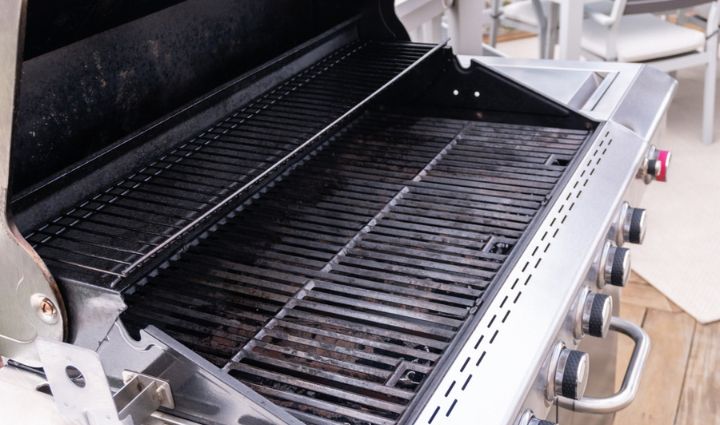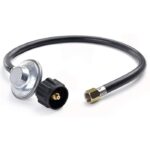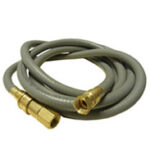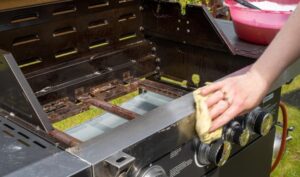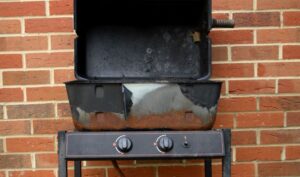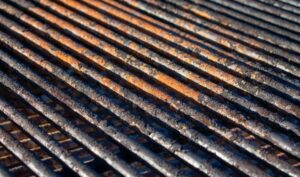Buying a used grill can save you money, but it’s important to inspect it thoroughly for cleanliness, rust, functionality, and brand quality before you buy. Some issues are major red flags, such as a rusted grill body, but other issues like rusty internal parts aren’t necessarily dealbreakers—especially if the price is right.
Buying a used grill isn’t all that much different from buying a used car. It may not be quite as high stakes, but all the same considerations are at play—the manufacturer, the age of the grill, the condition it’s in, ease of finding replacement parts, and of course, price.
If you’ve ever purchased a used car before, you know that it’s not as straightforward as it seems. Maybe you found a model from a reliable manufacturer with easy-to-source parts, but it’s out of your preferred price range. Or maybe you found a car with super low mileage in your price range, but it’s a bit older than you’d like. There are always trade-offs.
Buying a used grill may be a lower-pressure purchase than a new set of wheels, but it can feel just as confusing and complicated. Cruising through classifieds to find good deals on grills in decent condition is no easy task, with tons of listings to click through, blurry photos, vague descriptions, and prices that vary widely.
It takes time and effort to find a good used grill. Having a system in place to help weed out bad options can help make the process easier, saving you from picking up a used grill that turns out to be a lemon.
In this post, we’ll share our advice for buying a used grill, including:
- 7 things to look for when you go to see a used grill
- What to ask the seller before you buy a used grill
- Yellow flags, red flags, and absolute dealbreakers
- Other tips for buying a used grill
- Sample used grill listings
Let’s get grilling!
7 Things to Look For in a Used Grill
When you buy a used grill, you should always thoroughly inspect it before you commit. Ideally, your inspection would start online, but classifieds don’t always include the best pictures or descriptions. Do your best to glean what you can from the information provided, and keep these considerations in mind when you go to see a grill:
- How clean is it?
- What brand is it?
- How does the grill exterior look?
- Are there any rusty parts?
- Does it light?
- Are there gas leaks?
- How much does it cost?
How clean is it?
The first thing to assess when you’re looking at a used grill is its cleanliness.
Selling a dirty grill may not be the best look, but it’s not necessarily a dealbreaker. Grill grime can, however, conceal problematic rust and corrosion, so if the grill is quite dirty, be sure to do an extra thorough inspection.
You should also consider how much manual labor you are willing to do to get your new-to-you grill up and running. Deep cleaning a grill isn’t complicated, but it is time-consuming and it requires some serious elbow grease, so make sure you know what you’re getting yourself into before you commit.
What brand is it?
Just like with used vehicles, the manufacturer matters when it comes to buying a used grill.
Some grills are just built better than others, with higher quality materials and stronger construction. A well-cared-for used Weber grill, for example, could easily last you years longer than a budget-friendly store-brand grill bought brand new.
Weber, Napoleon, Char-Broil, Broil King, Traeger, and Big Green Egg are all brands worth looking into if you want a used grill. And who knows, you might even come across a super-premium grill brand like Kalamazoo, DCS, or Lynx at an affordable price.
If you’re looking for a used grill from a mid- or lower-tier brand, consider how much you’re saving and whether it’s worth simply buying a new grill, especially if you see rust and think you’ll need to replace parts.
How does the grill exterior look?
Are there any dents or holes in the grill’s exterior body? Is the paint peeling? Do you spot any rust? Are all the control knobs intact and functional?
Exterior grill problems are a red flag because most of these parts are usually not easily replaceable, and any DIY fixes are often just temporary solutions.
Plus, if the exterior looks rough, there’s a good chance the interior does as well.
Are there any rusty parts?
Check the cooking grates, heat plates, burners, and drip pan or grease tray for rust. Surface rust can often be cleaned, but serious corrosion or parts that are falling apart are a yellow flag.
Most rusty parts can be replaced with relative ease, but you’ll have to factor the cost of the new parts into the overall price of your grill. Depending on the listed price of the used grill, we recommend not buying one that needs more than 1 or 2 replacement parts.
GRILL SPOT TIP: If you suspect you’ll need new parts, confirm the make and model of the used grill before you buy it so you can check to see if replacement parts are available and how much they cost.
Does it light?
If the used grill in question is hooked up to a propane tank and the seller says it lights just fine, we recommend testing to double-check if it will light before you buy.
If there’s an electric igniter, does it click when you press the button? If it does click, do the burners end up lighting? If the burners don’t light, there’s a good chance all they need is a good cleaning. But if they look especially rusty, it might be easier to just completely replace them.
GRILL SPOT TIP: If the burners light, look for an even flame pattern with blue flames that have a yellow tip.
If the igniter doesn’t click, it may simply be a dead battery, the electrodes may be dirty, or there could be a loose connection. If it was recently raining, the igniter may also just be wet and unable to start. We might not buy a used grill with an igniter that doesn’t click if other parts also need replacing, but igniters are fairly easy to replace. If the igniter is the only troublesome part of the used grill, it need not stop you from taking it home.
Learn more about diagnosing and troubleshooting igniter issues
Are there gas leaks?
If you’re checking out a used grill, we recommend bringing some basic supplies along so you can test for gas leaks. To check for gas leaks, follow these steps:
- Make sure your gas supply is turned off and all control knobs are in the OFF position.
- Inspect all hoses on the grill, looking closely for signs of deterioration such as cracking, abrasions, holes, or tears. Ensure all the hoses are tightly connected and that there are no sharp bends or kinks in the gas line.
- If the propane tank is included, check it for rust, dents, bulges, corrosion, punctures, or other signs of damage.
- Mix a 50/50 solution of water and dish soap and apply it to the gas hose and connection points with a spray bottle or with a clean brush.
- Open the gas supply, but do NOT turn on the control knobs or light the grill. Do not smoke while testing for gas leaks.
- Inspect the hose and connection points. If you see growing bubbles forming at any point, this indicates a gas leak.
- Turn off the gas supply.
If you do find a gas leak, it isn’t a dealbreaker. Most gas leaks can be fixed by reconnecting or tightening the connection points. If you try this and still have a gas leak, you may need to replace the connector pieces.
Shop for replacement gas grill hoses:
How much does it cost?
Last but absolutely not least—the cost of the used grill. This is the most challenging factor to think through. Here’s our advice on used grill costs:
- Compare the listed price of the used grill to the original price of the grill, if you can dig up the info. There’s no hard and fast rule to follow here, but older grills should cost less than the original listed price (especially if they are a lower or mid-tier brand).
- Consider the age of the grill and what replacement parts you might need. Costs can add up, especially if you have multiple parts to replace.
- Higher-tier brands with solid construction, such as Napoleon and Weber, should come with a price tag to match. Cheaper brands are made with lower-quality materials, so they should come with a lower price tag.
- Compare prices for other used grills on the market. Are other people selling the same grill? How much are they selling it for, and what condition is it in? If you see someone selling the same model for a lower price, you can use this information to try to negotiate another price.
What to Ask the Seller Before You Buy a Used Grill
We recommend asking the seller a couple of questions in addition to your inspection:
- How old is the grill? Not every seller includes this information in their ad. If they don’t, ask when you go to see the grill. The condition of the used grill matters more than its age, but it can be harder to find replacement parts the older a grill gets.
- How is it stored? Uncovered grills are more likely to rust and require replacement parts. Grills that have been stored in sheds or garages, on the other hand, will likely be in the best shape.
- When was the grill used last? If it hasn’t been used in a couple of years, definitely test it to see if it lights. Be sure to thoroughly inspect the grill as well. Don’t skip any of the steps listed above.
Yellow Flags, Red Flags, and Absolute Dealbreakers When Buying a Used Grill
More Tips for Buying a Used Grill
Our grill repair experts have a few more tips to help you find the best deal and ensure you get a quality used grill:
- Always thoroughly inspect the grill before you take it home. Do not skip this step if you’re buying a used grill.
- Look for a used grill when demand is low, like the middle of winter when no one is grilling and demand for barbecues is lower.
- Search using alternative or incorrect spellings. If you really want a Weber grill for example, one YouTuber suggests searching for “webber” instead to find listings people may not see if they only search the correct spelling. You should also try variations of “barbecue,” “BBQ,” “grill,” and “smoker.”
- Make sure you have a big enough vehicle to fit the new grill. You may have to rent a cargo van like we did when we restored a rusty Cuisinart grill.
Would We Buy This Used Grill? Sample Used Grill Listings
In this section of the post, we’ll dig into 4 real used grill listings we found on Facebook Marketplace. We’ll inspect the photos, assess the brand and price, and explain why we would (or wouldn’t!) buy that particular used grill.
Let’s dig in.
EXAMPLE 1: Cuisinart 3-Burner Gas Grill (the same model we resurrected)
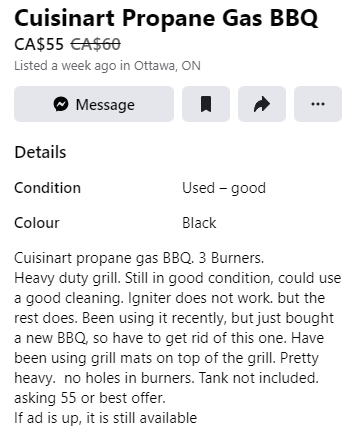
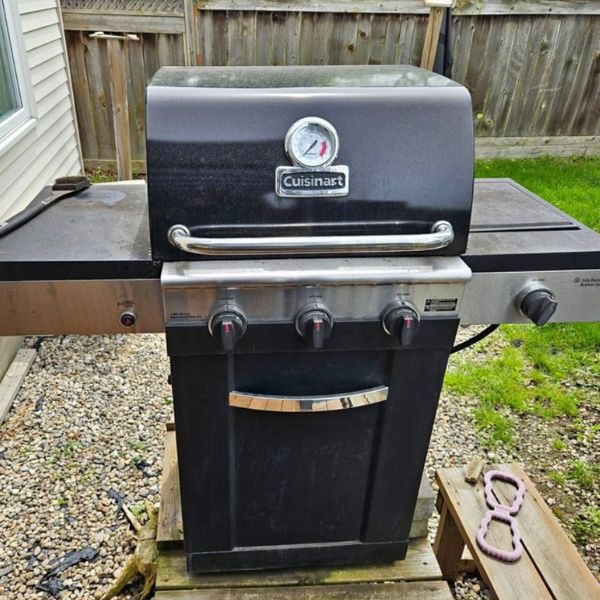

Would we buy this used grill?
Maybe.
Here’s why:
Cuisinart is a mid-tier brand and the exterior looks to be in good shape, but the interior of the grill looks like it could use a thorough cleaning. Let’s go under the hood:
- The grill grates and heat plates are intact, but they look pretty rusty. The grates should be replaced right away, and the heat plates will probably need replacing within a year. You’d need 3 new heat plates at $20 per heat plate and 2 new cooking grates at $28 per grate, so you’re looking at a minimum of $116 in replacement parts (plus tax and shipping).
- The listing claims the igniter doesn’t work, which makes it difficult to test if the grill is functional. After replacing the igniter—about $10-15—you may find you also need to replace the burners.
These repairs add up to $130 plus tax and shipping in known repairs and replacements. If you end up needing new burners, it’ll cost you an additional $48-$60. That’s all on top of the listed price of $60, which adds up to a total of $190 without burners, or up to $238-$250 with burners, not including applicable taxes and shipping fees (or vehicle rental if you need it).
This grill was originally sold for $469.99 plus tax, so even with all of these repairs, $250 isn’t a bad price—if you’re ready to do all the labor of cleaning and replacing parts.
We also found the same grill for sale by someone else for $240, but this one had little to no rust and no known igniter issues. We’d be more inclined to purchase this one, especially if it can be tested to confirm everything is working before you buy. It’ll be easier to get it going, with no need to scrub away rust or replace parts.
EXAMPLE 2: Weber Spirit II 3-Burner Propane BBQ
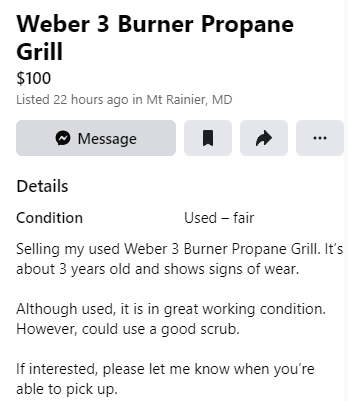
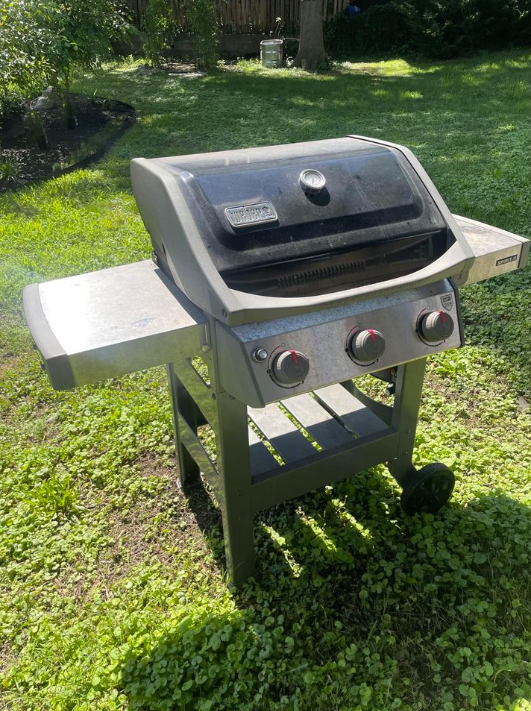
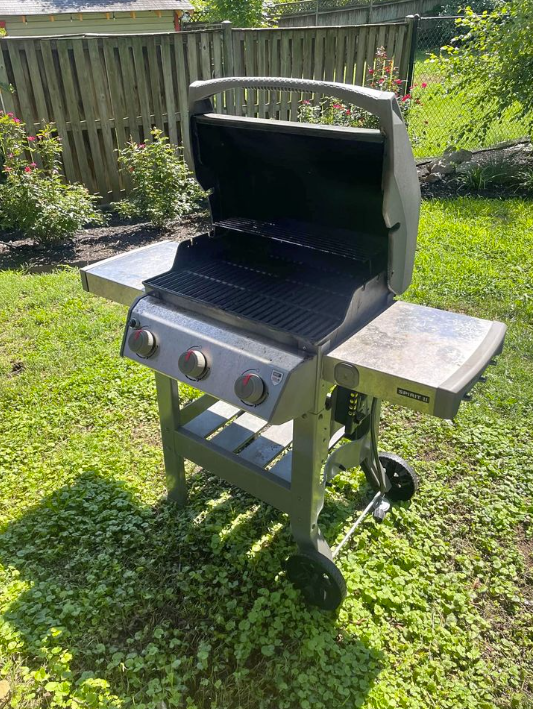
Would we buy this used grill?
Yes, pending an in-person inspection.
Here’s why:
- The exterior looks to be in decent shape, and it’s a Weber grill so we know the construction is good.
- It’s only 3 years old, which is relatively young for a Weber grill.
New 3-burner Spirit II grills start at $569, so even if you do have to replace a few parts, a price tag of $100 is a pretty low starting point (especially if you can negotiate the price down even further). - The description states there are “signs of wear”, and while there are no detailed photos, the photos provided don’t indicate any major rusting on the grill grates. Chances are, it’s the heat plates and possibly burners that need replacing.
- It looks relatively clean. We’d still give it a decent cleaning once we got it home just to make it feel as fresh as possible, but we don’t see any significant stuck-on grime to scrape off.
EXAMPLE 3: Weber Spirit II E-210 Propane BBQ
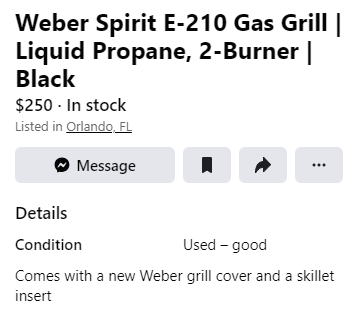

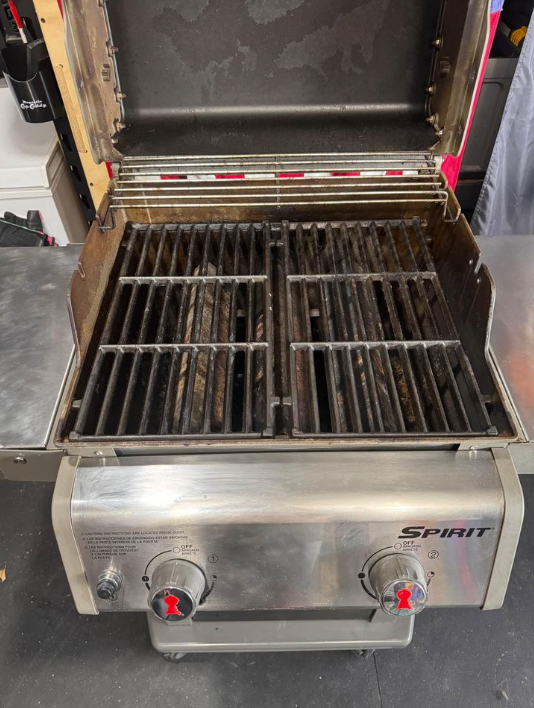
Would we buy this used grill?
No.
Here’s why:
The exterior and cooking grates look to be in good shape, but the interior shows wear. The heat plates need replacing, and the burners might be as well. Heat plates will cost about $53, and burners are about $55 (plus tax and shipping). That brings the total cost of the grill up to over $350. Spirit II 2-burner grills start at $449, so you aren’t saving much by buying used.
EXAMPLE 4: NexGrill 5-Burner Propane BBQ
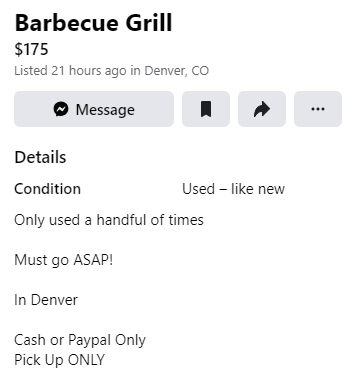
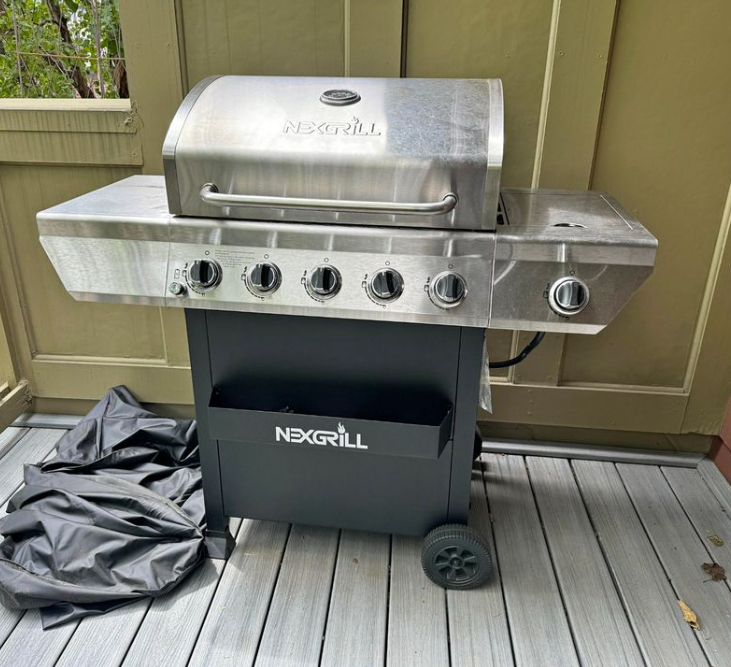
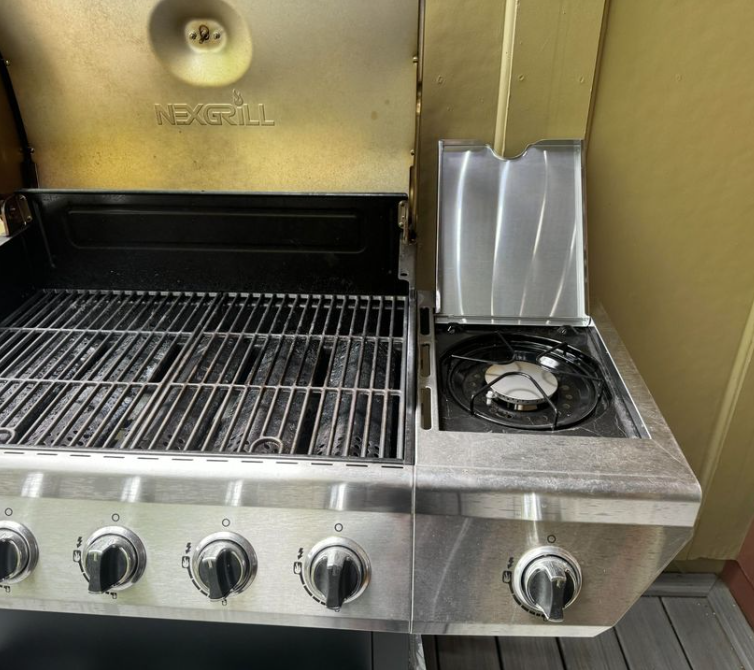
Would we buy this grill?
No.
Here’s why:
- The exterior is in good shape, as are the cooking grates. However, the heat plates are a bit questionable, and look like they’ll need replacing within a year or two. Each heat plate costs $20 (plus tax), so that’s a total of $100 on just replacement heat plates.
- This grill retails for $299 plus tax, so even though it’s only been used “a handful of times”, for an extra $125 (assuming you don’t replace the heat plates), we’d rather buy a brand new grill.
- NexGrill is a lower-to-mid-tier brand. Chances are, more parts will need replacing over time, and the construction overall is not as strong as other brands.
EXAMPLE 5: 22” Weber Charcoal Grill


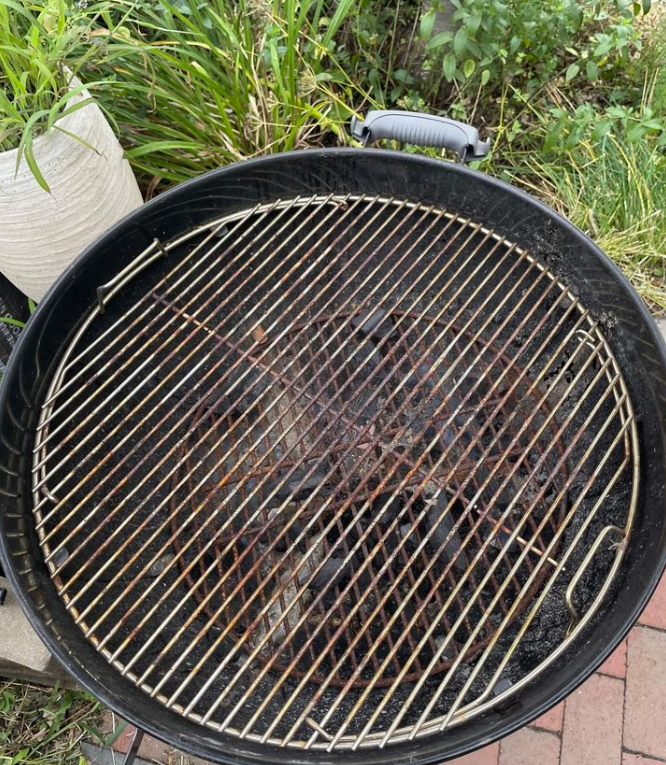
Would we buy this grill?
Yes.
Here’s why:
- The exterior is in good condition.
- The interior looks pretty good as well, except for the cooking grates, which need replacing. Cooking grates for this model cost about $20 (though there are more expensive options if you prefer a different material).
- This grill originally retails for $219. Even with replacement cooking grates, you’re saving a lot of money buying a used model.
- There are lots of accessories to add to this grill, such as char baskets and bowl cleaning kits.
Get Grilling
Buying a used grill can help you save money while still enjoying the pleasures of outdoor cooking, but finding a good used grill online can be a challenge. It requires careful consideration and a thorough inspection, but with our tips and advice, you can avoid common pitfalls and make an informed decision about a used grill.
Some grill issues are major red flags or dealbreakers, such as a rusted grill body. But a few minor repairs or rusty parts shouldn’t put you off of a used grill, especially if the price is right and the construction is solid.

